
2015 – Winners of the 11th Annual Archie League Medal of Safety Awards, honored on March 4, 2015 at the Rio in Las Vegas:
Alaskan Region: Parker Corts, Anchorage Center
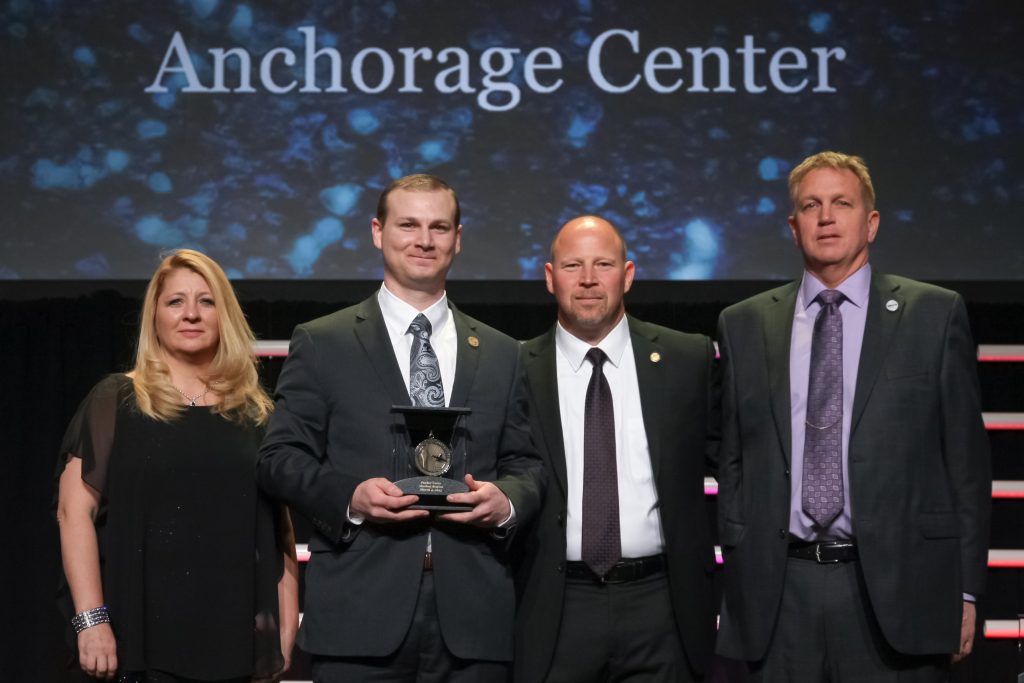
Anchorage Center NATCA member Parker Corts, a six-year air traffic control veteran, and a private, single engine instrument-rated pilot, was working the southeast Alaska sector on August 8, 2014, when he noticed a Comanche pilot was having trouble navigating. Corts cleared the pilot, who was inbound to Juneau, to the LYNNS intersection to begin the LDA X 8 approach into the airport.
For unknown reasons, the pilot was unable to find the intersection, so Corts vectored the aircraft for the localizer. He patiently gave multiple vectors and altitudes to the Comanche pilot, trying to keep the aircraft on course.
After issuing the aircraft a heading of 100, Corts noticed the pilot was not flying the heading, even though he had read back the clearance correctly. Instead, the pilot was flying a 010 heading and heading directly for higher terrain. At that point, Corts’ expertise and instincts as an air traffic controller and pilot kicked in. He knew something was not okay in the aircraft.
Corts: N67P, fly heading 1-0-0, vector to intercept the localizer, proceed inbound, maintain 7,000, report established on the localizer.
N6267P: 67P to turn 1-0-0 to intercept the localizer and maintain seven until doing so.
Corts: N67P, say heading.
N6267P: 67P is heading 0-1-0.
At no time did the pilot offer that he was having trouble, but he clearly was unable to maintain headings or altitudes, find fixes, or tune in to VORs. Finally, the pilot mentioned that his equipment did not appear to be working correctly. Corts, knowing full well the implications of malfunctioning equipment near terrain, immediately enlisted the assistance of another aircraft in the area. He asked the pilot to relay several vital transmissions to the aircraft in distress. Corts, through the assisting pilot, was able to help the Comanche pilot in navigating to an area where he could maintain ground contact.
Corts: N67P, roger, do you have any reference at all or are you straight in the clouds?
N6267P: 67P still in the clouds.
Corts: Okay, N67P, roger, I’m going to try and take you southbound through a cloud break. The ceiling’s been reported at 5,600 feet, turn 30 degrees left, I’ll give you a “stop turn” when you need to stop turning. Turn at a standard rate.
N6267P: 67P turning left and maintaining 8,000.
Corts: N67P, stop turn.
N6267P: 67P stop turn.
N6267P: 67P has excellent ground reference right at this moment.
When Corts could maintain communications with the Comanche, he gave the pilot locations of nearby airports and their weather conditions. He assisted the pilot in finding another airport with better conditions: Gustavus. Because of Corts and his quick thinking, the Comanche pilot made a visual approach into Gustavus and landed safely.
BELOW: Watch the award presentation.
BELOW: Watch and listen to highlights from this save event.
Central Region: Travis Arnold, Omaha TRACON
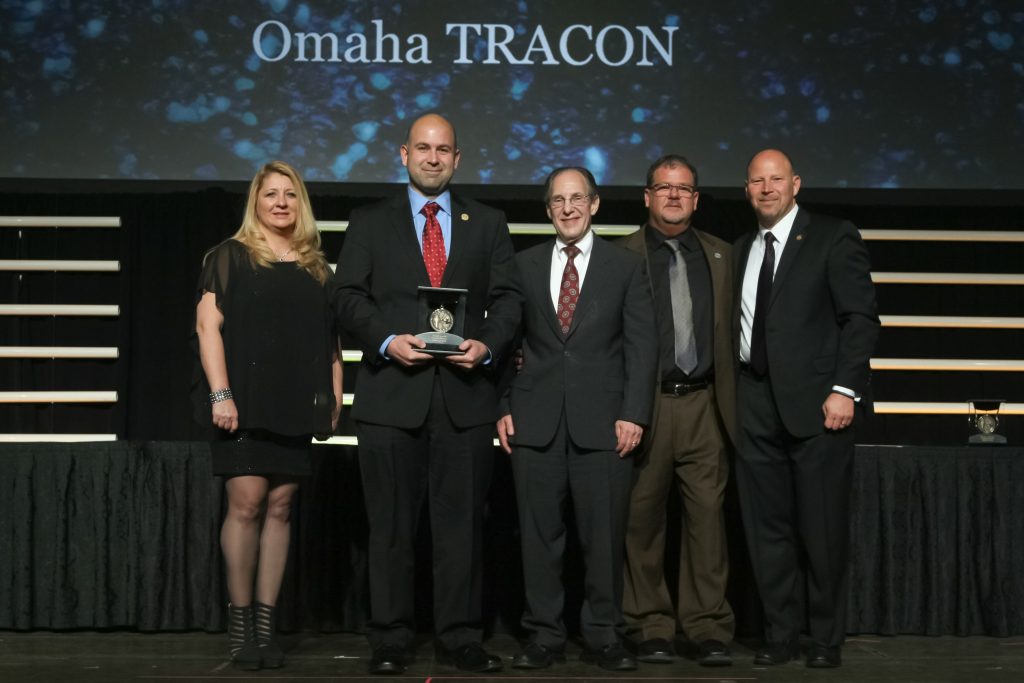
Omaha TRACON (R90) NATCA member Travis Arnold is an experienced controller. He served in the United States Air Force from 2001-2007, during which time he deployed to Iraq twice. In February 2008, he became a civilian controller at Des Moines ATCT before transferring to R90 in January 2009.
On Dec. 13, 2014, Arnold was working the Lincoln sector at R90. The weather was IFR with 800-foot ceilings and eight mile visibility, which warranted all arrivals into Lincoln be ILS. N4120S was being vectored for the ILS approach when Arnold noticed the pilot seemed to be struggling with the headings he was given. Arnold initially thought the winds were causing the discrepancy in the headings the pilot was flying, and he quickly issued corrective headings.
When the pilot was near the final and cleared for the ILS runway 18 approach, Arnold once again noticed that the pilot passed across the final approach course. Arnold immediately made the pilot aware of this and issued a corrective heading again to get the pilot turned back towards the localizer. Even though the pilot acknowledged the turn, Arnold knew something was not right.
After the pilot called Arnold to ask if he knew what was happening, Arnold asked the pilot if his gyro was working. The pilot responded he was receiving crazy readings from his instruments.
Arnold decided to turn the aircraft back towards Lincoln by issuing no-gyro turns to the pilot. He advised the pilot he was a little higher than the last assigned altitude, but wanted to make sure the pilot was straight and level prior to issuing the no-gyro vector.
The aircraft was within seconds of issuing a turn, Arnold noticed the aircraft was descending below the minimum vectoring altitude. He issued a low altitude alert and instructed the pilot to climb to 3,000 feet. The pilot acknowledged. However, the aircraft continued to descend. Arnold issued another low altitude alert and again instructed the pilot to climb. He immediately instructed the pilot to stop his turn and climb to 4,000 feet. The pilot mentioned he had ground contact and was currently at 2,000 feet. He proceeded to climb to 4,000 feet again and was eventually able to fly above the clouds where he was able to get his equipment working again.
Later communication with the pilot revealed that originally the pilot did not realize he had descended. However, once he was near the cloud base and he saw the ground, he just wanted to land the aircraft safely in the nearest field. It was because of Arnold that the pilot had the confidence to once again climb through the clouds, get his equipment working, and safely land at Lincoln.
BELOW: Watch the award presentation.
BELOW: Watch and listen to highlights from this save event.
Eastern Region: Joseph Rodewald, Potomac TRACON
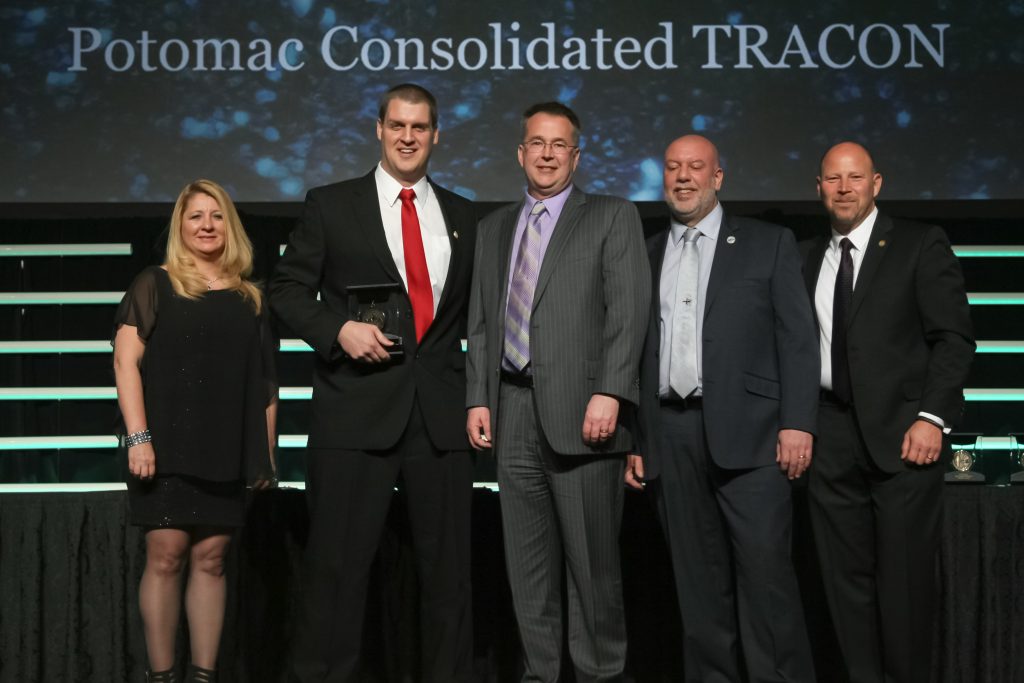
On October 5, 2014, NATCA member and Potomac Consolidated TRACON veteran member Joe Rodewald was working Charlottesville approach when he noticed two aircraft squawking VFR in the same vicinity. The aircraft appeared to be on converging courses at the same altitude. Rodewald immediately began broadcasting in the blind in hopes that one or both aircraft were monitoring his frequency.
Rodewald: Traffic 10 miles east of Charlottesville westbound you have traffic at your 11 o’clock and two and a half miles northeast bound indicating 4,900.
Rodewald: Traffic eight miles northeast of Charlottesville, northeast bound traffic at your one o’clock, one and a half miles westbound indicating 4,600.
When the aircraft were two miles apart, the pilot of N811LJ, who was proactively monitoring the frequency, acknowledged and answered Rodewald’s calls. He responded, “looking.” Rodewald continued to make traffic calls until the pilot reported the traffic in sight.
Rodewald: Traffic is now one mile apart converging.
N811LJ: 1LJ has the traffic in sight, thanks for the call out.
When the pilot finally got the other traffic in sight, the two aircraft were less than a mile and indicated 100 feet apart. Rodewald solicited flight following to N811LJ, and the pilot immediately accepted the offer.
Rodewald: Seneca 1LJ, would you like flight following?
N811LJ: Uh, sure. 1LJ is VFR headed to Warrenton.
Rodewald: 1LJ, reset transponder squawk 0-4-2-5.
N811LJ: 0-4-2-5 for Seneca 811LJ.
Rodewald saw a conflict and quickly took the necessary steps to fix the issue and keep his airspace safe.
BELOW: Watch the award presentation.
BELOW: Watch and listen to highlights from this save event.
Great Lakes Region: Adam Helm, Justin Krenke, and Mike Ostrander, Green Bay Tower/TRACON
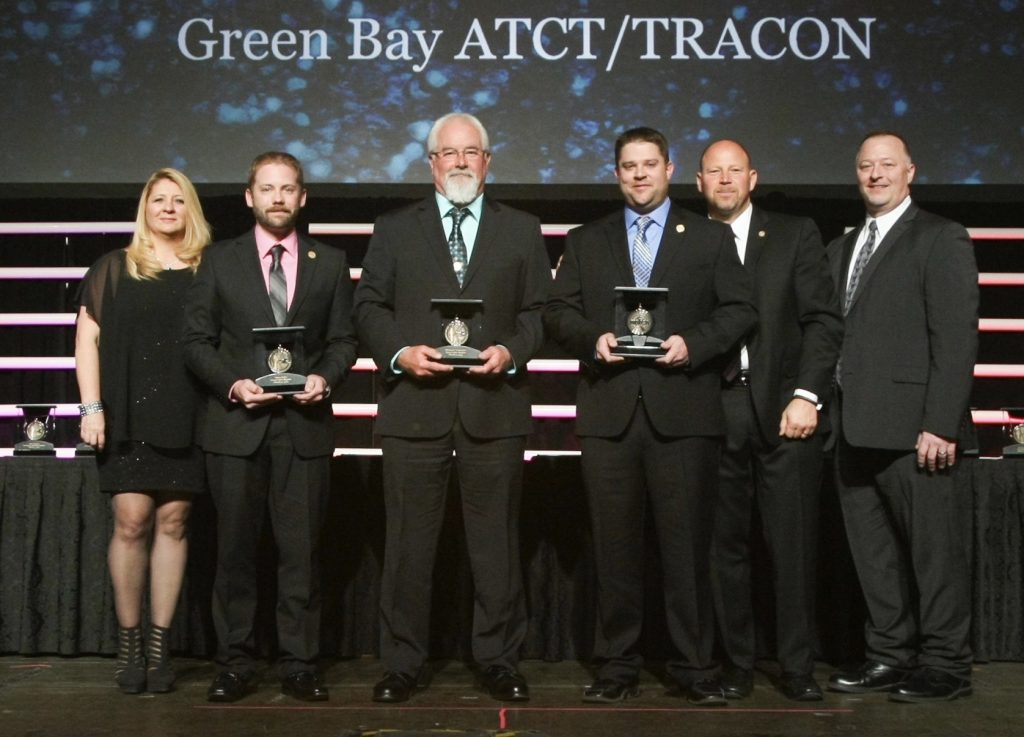
On February 13, 2014, Green Bay Tower/TRACON (GRB) NATCA member and former airline pilot Justin Krenke was working a satellite position in the TRACON when a Beechcraft Baron was inbound to Menominee, Wisc. (MNM) from Rochester, Minn. Because of known icing in the area, Krenke told the pilot to descent to 3,000 feet at his discretion. Upon initial descent, the aircraft did indeed encounter icing.
Due to the minimum vectoring altitude in the area, Krenke was not able to descend the pilot any further, however, he did offer a straight in approach to MNM. The pilot declined and asked to continue for the initial approach for which he was set up.
At this time, NATCA member and single engine instrument rated pilot Adam Helm passed through the TRACON on a break and he heard the pilot was concerned about the icing. After the pilot could not safely descend any further, he asked to climb above the icing conditions and informed Krenke that his gyro had spun. The controllers knew they needed to work quickly.
Krenke climbed the aircraft to 4,000 feet, while NATCA member Mike Ostrander quickly called Minneapolis Center to let them know they were handling the aircraft as an emergency, and the pilot needed to climb past 4,000 feet. Krenke climbed the aircraft to 6,000 feet, then 8,000 feet, in an effort to climb above the icing conditions.
Helm pulled weather reports from satellite airports to try to find one that had higher ceilings. He even called Minneapolis Center and Milwaukee TRACON to ask if they had any airports in their area with visual flight rule conditions. There were none.
The pilot began to descend and head towards GRB. Mindful of the icing and pilot-reported equipment malfunction, the controllers started to prepare for a possible emergency ASR approach to GRB. As time progressed, it became evident that the pilot was having an increasingly difficult time maintaining headings and altitude due to the icing. About 20 miles from GRB, the pilot declared an emergency and descended below the minimum vectoring altitude in an attempt to get under the icing conditions.
The controllers jumped into action and relayed possible obstructions to the pilot. They also found an alternate airport where the pilot could land, Oconto Airport (OCQ). Helm called the Oconto police dispatcher and advised that there was an aircraft in distress that would be attempting an emergency landing at the uncontrolled satellite field, and that emergency services would be required.
Krenke vectored the aircraft over OCQ several times while Helm stayed on the phone with the dispatcher. The pilot stated that there were plows on the runway so he was not able to land. The controllers quickly told the dispatcher the plows needed to vacate the runway. On the next pass, they lost radar and communication with the aircraft, but the dispatcher relayed that the aircraft had crash landed.
Thanks to Krenke, Helm, and Ostrander, the pilot and his passengers survived the crash landing.
BELOW: Watch the award presentation.
BELOW: Watch and listen to highlights from this save event.
BELOW – Media coverage:
CBS5 Green Bay
Green Bay Press-Gazette
New England Region: Kelly Eger and Sarah LaPorte Ostrander, Boston Tower
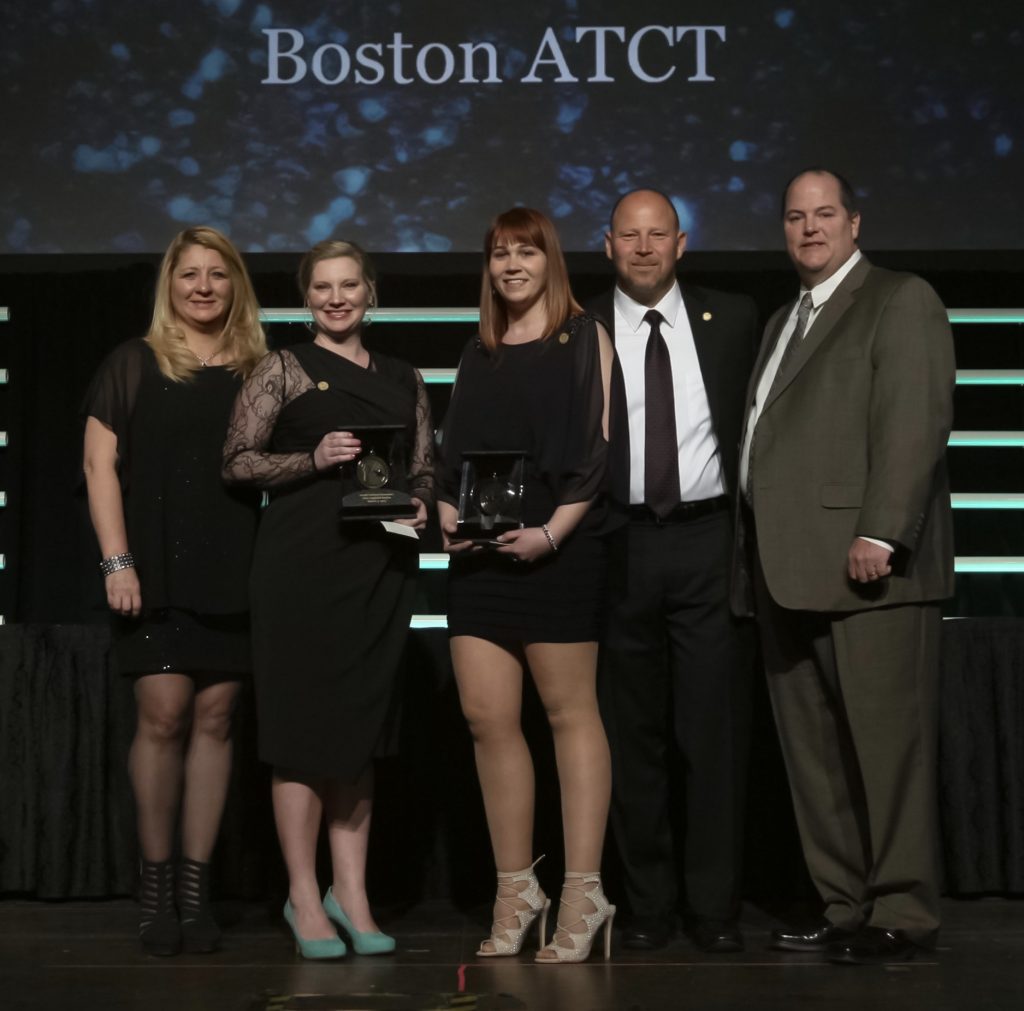
On September 15, 2014, Boston ATCT air traffic controller Kelly Eger was working the local west position and Sarah LaPorte Ostrander was training someone on ground control. The airport was beginning to back up with traffic because of the evening rush, so the controllers were working quickly and efficiently.
JetBlue 405 was not going to make the departure sequencing time, so a new one was coordinated. Because of this, the JetBlue aircraft had to be taken out of the sequence of aircraft awaiting takeoff. Eger decided to move the aircraft across runway 22R at runway 15L. She told the pilot to turn onto runway 15L and hold short of runway 22R.
Eger: JetBlue 405, Boston Tower, turn right on Runway 1-5 left and hold short of Runway 2-2 Right.
JBU405: Turn right on 1-5 Left, we’ll hold short of Runway 2-2 Right, JetBlue 405.
Eger: JetBlue 405, you have a release time of 4-8.
The pilot responded correctly, so she continued and cleared a United flight for takeoff. The United flight began its initial takeoff roll and was moving swiftly down the runway when Ostrander observed the JetBlue aircraft not stopping, putting it on a direct collision course with the United flight. With United picking up considerable speed due to takeoff, the planes were looking like they would be at the same spot on the runway at the same time. Ostrander quickly alerted Eger, who saw the incident at the same time, and Eger told JetBlue to stop.
Eger: And JetBlue 405 hold short of 2-2 Right, stop.
Eger: Stop.
JBU405: We’re stopped.
JetBlue stopped just before the ASDE-X alert went off in the control tower. Thanks to the teamwork and professionalism of Eger and Ostrander, United departed safely.
BELOW: Watch the award presentation.
BELOW: Watch and listen to highlights from this save event.
Northwest Mountain Region: Matt Dippe, Mark Haechler, and Alan Passero, Seattle Center
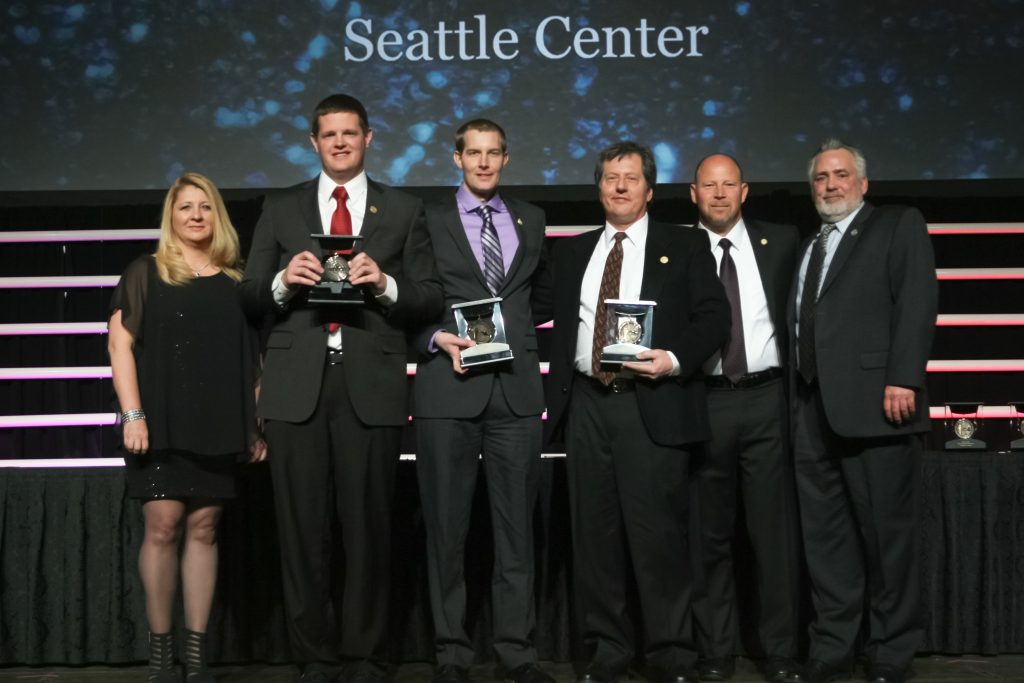
On the evening of November 1, 2014, a Cessna Skyhawk departed on an IFR flight plan from Klamath Falls airport en route to Boeing Field airport. The aircraft was making a return flight, having flown a VFR flight that turned into an IFR flight earlier in the day. The pilot was unable to maintain VFR and flew into icing conditions, but did not have to declare an emergency.
On the return flight, however, the pilot ran into more trouble, including icing, downdrafts, terrain, and deviating from his course. Mark Haechler, a trainee at the time, was assisting the pilot before conditions deteriorated too much. As the pilot continued having problems controlling the airplane, Al Passero and Matt Dippé both came to assist him in getting the pilot to land safely.
Haechler: N48E, report leaving 8,800.
N3048E: Uh, we are actually still at 8,500, so we will inform you when we leave 8,800, 48E.
Haechler: N48E, I’m showing you, ah, actually in a descent. I did show you at 8,600. Now I show you out of 8,400.
N3048E: Yeah, I think we were getting some downdrafts there. We’re trying our best to get it up, 48E.
Haechler: N48E, I need you to expedite your climb to 10,000 for terrain.
The trio declared an emergency and quickly began working together to help the pilot out of the inclement weather. The aircraft could not climb, so Haechler turned the pilot back towards lower terrain and Klamath Falls airport. Passero suggested one approach that the aircraft was already close to, but the aircraft was not DME equipped and therefore did not have the approach plate. Haechler, Passero, and Dippé quickly moved on to an alternate plan.
N3048E: Still getting some downdrafts, unable to climb. Can you give us some vectors around the terrain, please, 48E?
Haechler: N48E, uh, you are below my terrain and unable to climb, I am now declaring this an emergency. Turn right heading 0-2-0 for, uh, terrain.
N3048E: 0-2-0, 48E, roger.
Haechler: N48E turn right heading 1-4-0, vector for terrain, and once you climb to 10,000, I will have on course for you, sir, but my minimum IFR altitude in your area is 8,800.
Because the aircraft had become an emergency, the controllers decided to have the Skyhawk pilot fly the approach, while vectoring him to the final approach course. This would allow the controllers to step him down to the airport gradually while still monitoring his actions. Throughout this, the pilot repeatedly turned west and they would have to correct his course to get him back on track.
Haechler: N48E, I show you westbound, sir. You should be established on a 3-1-4 radial proceeding towards Klamath Falls VOR.
N3048E: You’re telling us to do the VOR DME Runway 1-4, right, 48E?
Haechler: N48E, affirmative, sir. I need you established on the Klamath Falls 3-1-4 radial.
Eventually, the pilot broke out of the weather and was able to see the airport. Haechler, Passero, and Dippé were then able to transfer him to the tower where the pilot made a safe landing.
BELOW: Watch the award presentation.
BELOW: Watch and listen to highlights from this save event.
MEDIA COVERAGE:
KOMO-TV Seattle
KOMO-AM Seattle
KOMO radio Seattle (Feb. 25, 5:30 a.m.)
KIRO-TV Seattle
Southern Region: Sarina Gumbert, Central Florida TRACON
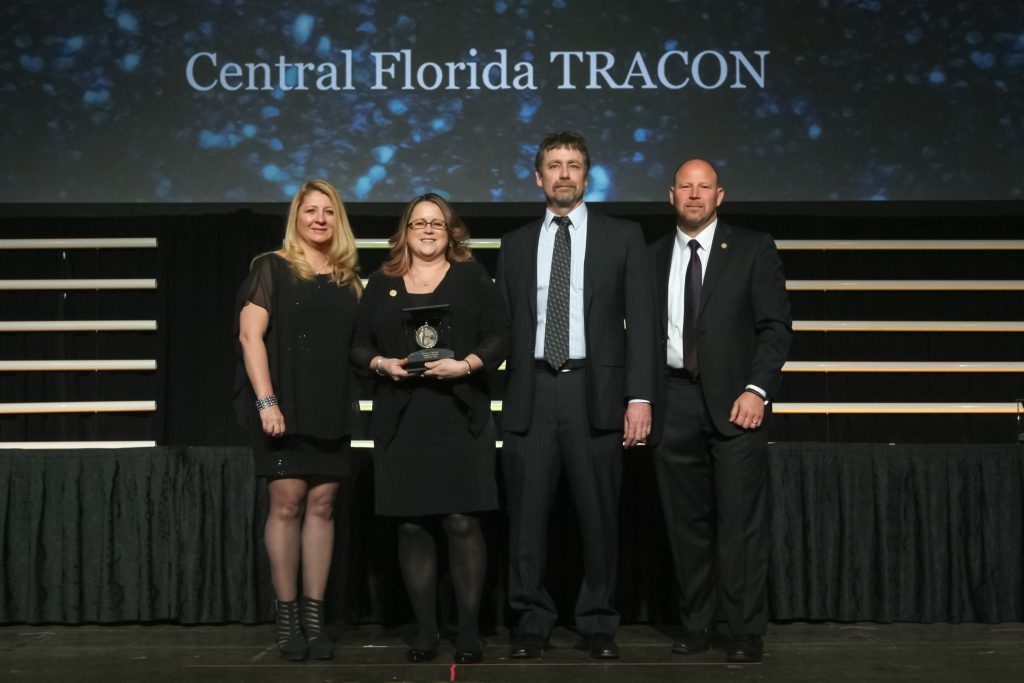
Just before noon on October 24, 2014, Sarina Gumbert, a seven-year veteran controller at Central Florida TRACON (F11), was working the Departure Radar West (DRW) position. The day before was the final day of the National Business Aviation Association conference, so traffic was slower than the previous few days.
At the time, Gumbert was working only one other aircraft when N7876C entered her airspace and called her. N7876C was a Cessna Citation Mustang that just departed Runway 36L from Orlando International Airport (MCO). The tower controller at MCO had assigned N7876C a 015 heading after departure, which he correctly read back. When the pilot of N7876C called DRW, he stated that he was turning right to 015. The read back was correct. The DRW position typically covers a range of about 45 to 50 miles of airspace. Looking at this much airspace, it is somewhat difficult to observe, in a split second, when an aircraft is not flying the correct heading, especially when a pilot says the heading you expect him or her to state.
Gumbert immediately observed the errant heading the pilot was flying and instead issued a 360 heading and asked him what his assigned heading was. The Citation pilot again read back 015. Gumbert’s experience and instincts told her otherwise, though. Without hesitation, she told the pilot to turn left immediately and called out traffic that was departing the east complex of the airport. At this point, N7876C was tracking 097 degrees, aiming directly at JetBlue 94, who had just departed Runway 35L at MCO.
Gumbert: N76C, Orlando Departure, radar contact. And, uh, turn left heading 3-6-0, please. What was your assigned heading?
N7876C: 0-1-5.
Gumbert: 06C, turn left immediately, traffic departing the east complex out of 700 an E-190. It appears you’re eastbound.
Gumbert: N76C, traffic alert. Traffic immediately beneath you E-190, 1,000 feet. Say your heading.
After changing the pilot’s heading, there was no response from him. Gumbert continued to maintain her professionalism and calmly issued a traffic alert before again asking the pilot of N7876C his heading. Finally, he casually replied that his heading was 360. Gumbert then issued the Citation an immediate left turn to 270. Instead of questioning the pilot’s actions, she instantaneously attempted to mitigate the situation.
Gumbert: N76C, turn immediately, heading 2-7-0. Immediately.
N7876C: 2-7-0, 76C.
The Citation and JetBlue aircraft narrowly avoided one another during takeoff, a result of Gumbert’s vigilance and expertise.
BELOW: Watch the award presentation.
BELOW: Watch and listen to highlights from this save event.
MEDIA COVERAGE:
Orlando Sentinel
Orlando Sentinel (Editorial page feature)
WFTV-TV Orlando
WFTV-TV Orlando, story after the awards banquet
Central Florida Ch. 27 (Orlando)
Central Florida Ch. 27 (Orlando) coverage after awards banquet
News 13 Orlando
Southwest Region: Hugh McFarland, Houston TRACON
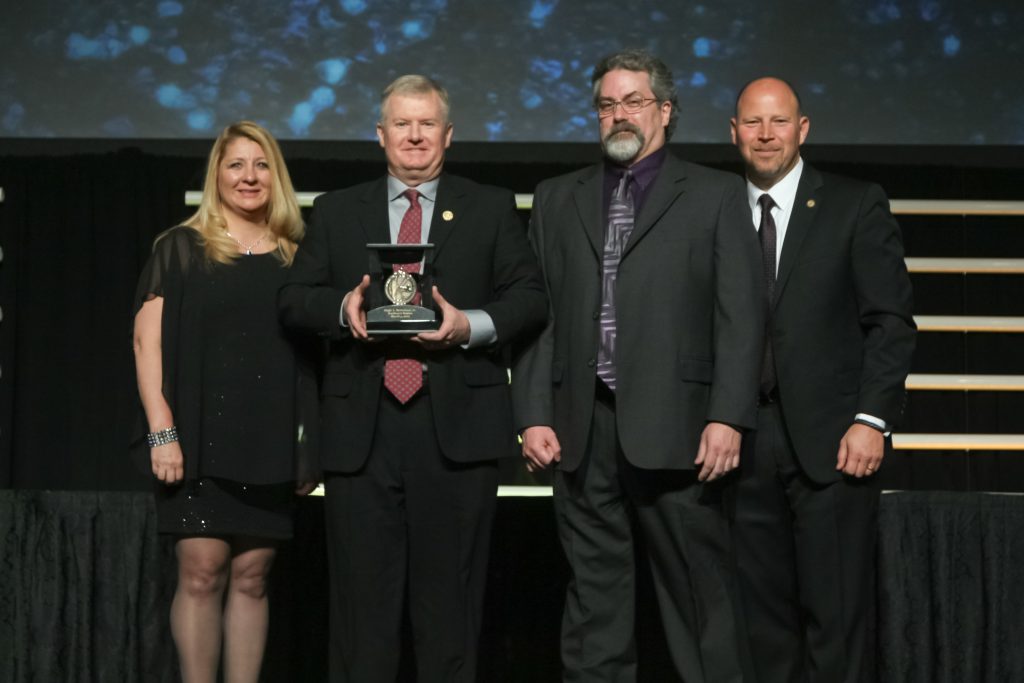
On November 16, 2014, longtime Houston TRACON NATCA member Hugh McFarland received a call from a distressed pilot who had become stuck on top of solid Instrument Flight Rules (IFR) weather. The pilot was only Visual Flight Rules (VFR) certified, and had encountered the weather conditions while en route from Kerrville, Texas, to David Wayne Hooks Airport, just north of Houston. After flying towards Houston for almost two hours, the pilot knew he needed more help.
After McFarland received the call from the pilot, he immediately began to make a plan to get the pilot safely on the ground. The weather the pilot was stuck on top of was almost 8,000 feet thick, and the conditions extended hundreds of miles around the Houston area. There was almost no chance the pilot could have flown his Cessna 172 to an airport with reported VFR conditions with the remaining fuel he had on board.
The decision was made to attempt a descent through the weather and have the pilot land at Houston Executive Airport (TME).
As a Beechcraft Baron aircraft owner and certified multi-engine instrument rated pilot himself, McFarland understood how critical it was that the pilot be able to land at TME. For 20 minutes, McFarland acted as the pilot’s navigation equipment and eyes through the weather. He prepared the pilot for the descent into TME, helped the pilot load up his GPS with the airport’s information, constantly reminded the pilot of his airspeed, bank angle in the turn, to stay calm, to breathe, to trim the aircraft, and to ensure the carburetor heat was on to prevent icing, among other things.
McFarland: N59G, you’re doing great, just keep the wings nice and level and airspeed about 85-90 knots, enrichen the mixture just a little bit more. Not all the way, but just a little bit.
McFarland: N59G, if you’re having to apply carburetor heat, go ahead and pull the carburetor heat knob out.
N4859G: Carburetor heat has been out, thank you.
McFarland: Roger.
McFarland: N59G, doing great, about another 500 feet to go, just continue southbound, heading 1-8-0, wings nice and level at 1-8-0, and just maintain 2,000 when you get there. About another 500 feet to go.
McFarland: N59G, when you’re ready, just make a standard-rate turn to the left, it’ll be just about 10 to 15 degrees of bank to the left, into a 0-9-0 heading, just due eastbound, just nice gradual turn, and use the turn coordinator and your attitude indicator to make just an easy turn to the left, about 15 degrees of bank.
McFarland also used landmarks to help assist the pilot in finding the airport. At 700 feet mean sea level, the pilot finally saw the ground. As the pilot descended lower, McFarland lost radar contact with the aircraft, but continued to provide the position of TME relative to the last known position of the aircraft until he heard the pilot had safely landed his aircraft.
BELOW: Watch the award presentation.
BELOW: Watch and listen to highlights from this save event.
Western Pacific Region: Jesse Anderson, La Verne Brackett Tower
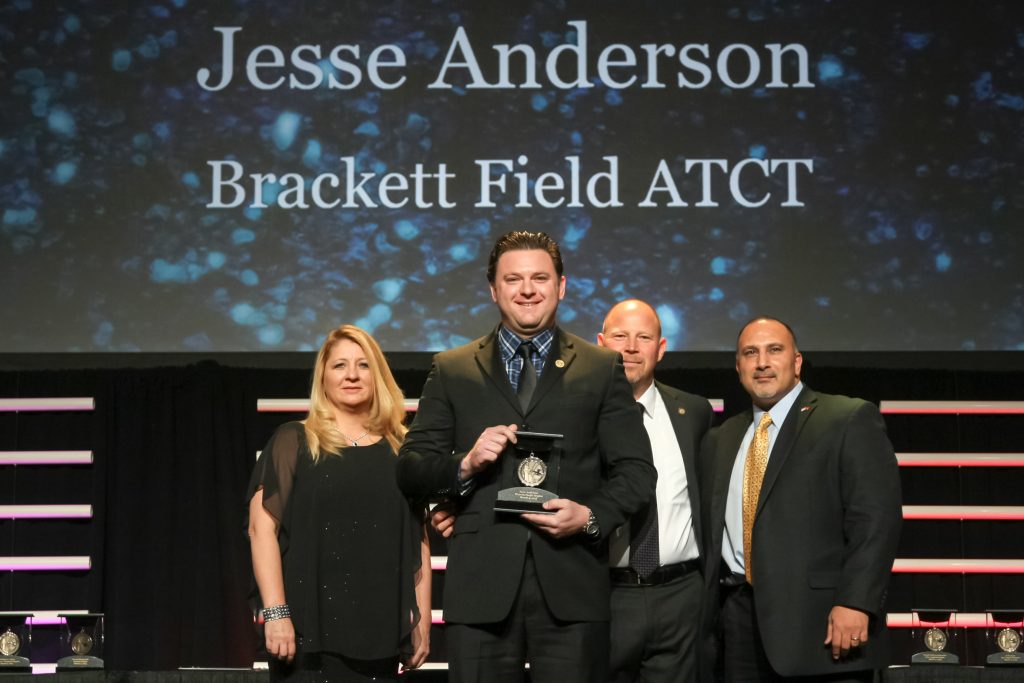
On December 7, 2014, Jesse Anderson, a seven-year veteran air traffic controller at Brackett Field ATCT, was working a local control position when N1120Z was inbound from the east. Anderson, who was working two other aircraft at the time, told the pilot of the Cessna Skyhawk the ATIS information when he requested it, rather than having the pilot switch frequencies.
After, Anderson realized the Skyhawk pilot turned towards Cable Airport, a private, uncontrolled airport four miles northeast of Brackett, putting him and other pilots flying in the airspace in danger. Anderson quickly called N1120Z and told him to turn away from the airport, while giving traffic alerts. During this time, the pilot inadvertently joined the downwind for Cable and was in conflict with all three aircraft who were in the pattern.
Anderson: Cessna 20Z, traffic 12 o’clock one mile opposite direction, altitude indicating 2,300.
N1120Z: Altitude 2,000, uh, 2,300.
Anderson: Cessna 20Z, traffic passing off your left, traffic alert 2,300 eastbound, type unknown.
N1120Z: Traffic in sight, 20Z.
Anderson observed N1120Z turn northbound and told him to turn east instead, away from the other aircraft. Once established on a course away from Cable, Anderson then told the Skyhawk pilot to turn right on a suggested heading of 260. Once he observed N1120Z turn east, he told the pilot to continue his right turn and finally got him flying west towards Brackett again.
The pilot was now on the right track to land at Brackett Airport. However, he needed to climb to avoid terrain, so Anderson quickly issued him a safe altitude. As he was climbing, the pilot called Anderson and, sounding distressed, told him he was directly facing the sun and could not see the airport. Anderson swiftly and effectively worked the traffic and assisted the disoriented Skyhawk pilot. He continued to talk to him in a calm voice to help the pilot reorient himself and get the airport in sight.
N1120Z: 20Z, uh, up at 2,500, I missed the runway; I cannot see the runway because the sun is in my eyes.
Anderson: Cessna 20Z, continue westbound, you’re lined for Cable airport, just continue westbound, do you have the 210 freeway in sight?
N1120Z: I see this, Runway 2-4, it says Cable, Cable runway?
Anderson: Cessna 20Z, affirmative, that’s Cable, just continue westbound, continue on that heading.
N1120Z: Continue heading, 20Z.
N1120Z: May I turn back on 2-6, Brackett, 20Z?
Anderson: Cessna 20Z, just continue that heading for Brackett, just go fly straight ahead on that current heading.
N1120Z: Oh I see I missed…oh I, thank you, thank you, thank you.
N1120Z finally found the airport and safely landed. After landing, the pilot was audibly upset, scared, and had accidentally turned the wrong way off the runway. Anderson continued to direct the pilot to where he needed to be.
Anderson: Cessna 20Z, you can turn right at Echo, that’s the taxiway in front of you, cross the yellow hold bars, then contact ground 125.0.
N1120Z: Okay, turning right here, 20Z.
BELOW: Watch the award presentation.
BELOW: Watch and listen to highlights from this save event.
President’s Award: Hugh McFarland, Houston TRACON
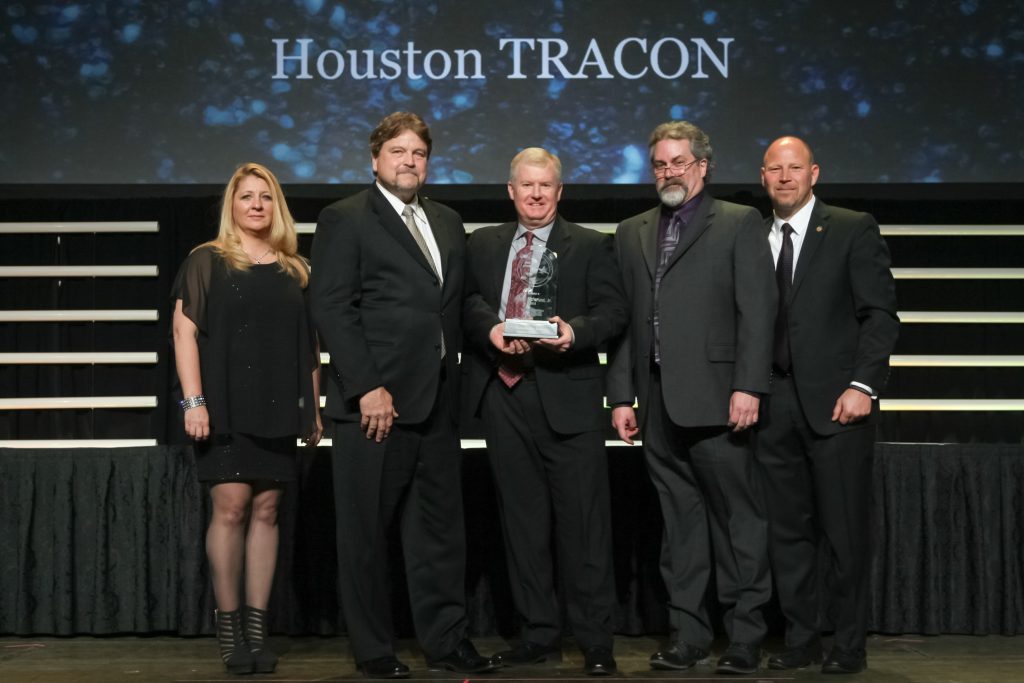
BELOW: Watch the award presentation.
BELOW: Watch and listen to highlights from this save event.
Honorable Mention
ALASKAN REGION
Glen Denning, Louis Miller, Anchorage Center
CENTRAL REGION
Eric Morgan, Kansas City ATCT
Kurt Nauman, Kansas City Center
Mark Schad, St. Louis TRACON
EASTERN REGION
Michael Hinson, Christopher Marovich,
Jeffrey Simmons, Huntington ATCT
Christopher Lane, Norfolk ATCT
Thomas Prestia, Morristown ATCT
Robert Robinson, Potomac TRACON
Isaiah Warren, Steven Fleischer, Andrew Biegel,
Kevin Southard, New York Center
GREAT LAKES REGION
Joel Fournier, Todd Gonnella, Chicago Center
Laura Kuhn, Mitch Becker, Minneapolis Center
James Whitaker, Cleveland ATCT
NEW ENGLAND REGION
Derek Morrison, Boston ATCT
NORTHWEST MOUNTAIN REGION
Courteney Carroll, Boise ATCT
Clint Click, Denver Center
Nicholas Gonzalez, Portland ATCT
Andy Olson, Seattle Center
Jeff Rawson, Salt Lake City ATCT
SOUTHERN REGION
Dan Benitez, Brandon Rosario, Jeff Warters,
Stuart Hahn, Eddie Alejandro, Rafael Pichardo, Miami Center
Curtis Collier, Louisville ATCT
Margaret Holbert, Tampa ATCT
Mike Hoprich, Charlotte ATCT
Steve Wright, Kevin Rogers, Memphis Center
SOUTHWEST REGION
Shay Bowling, Amarillo ATCT
Ben Foutz, Dave Bricker, Albuquerque Center
James Gallegos, El Paso ATCT
David Gilday, Curtis Braziel, Fort Worth Center
John Poropatic, Ryan Peterson, Joey Brown, Roswell ATCT
Marty Spiller, Matt Sheffield, Kristen Lewandowski, Austin ATCT
Michael Trysnicky, Crystal Kendzierski, Stephen Groves, Tulsa-R.L. Jones, Jr. ATCT
WESTERN PACIFIC REGION
Nathan Fischer, Montgomery Field ATCT
James Hansmann, Los Angeles Center
Lee Westfall, Burt Erikson, Zoem Patel, Dennis Julianna, Los Angeles ATCT
Paul Zoccali, Las Vegas ATCT


